High Level Summary of Statistics: Key Trends for Scotland 2006
Presents key trends for Scotland across all areas of governement activity.
5. Lifelong Learning
Universities and Colleges
Higher Education Students at Higher Education Institutions ( HEIs)
Since 1994-95, the number of higher education students studying in Scotland's HEIs has been steadily increasing. Increases have been experienced at all levels of study, however the highest rise has occurred in the number of students undertaking sub-degree level study in HEIs. The number of HE students in HEIs has increased by 51% over the period 1994-95 to 2004-05 to 224,390.
The percentage increase in student numbers over this period by each level of HE study differ significantly. Study at first-degree level has increased by 24%, whilst postgraduate student numbers have increased by 76% and sub-degree level by 241%.
The differing rate of increase in student numbers at each level of study has changed the proportion each level contributes to the total. In 1994-95, first degree level contributed 71% of the students at HE level in HEIs, whereas in 2004-05 this stood at 58%. In contrast, postgraduate and sub-degree study now make up a higher proportion of this cohort. Postgraduate students now account for 25% (in 1994-95 their contribution to the total was 22%) and sub-degree students make up 17% of the total (7% in 1994-95).
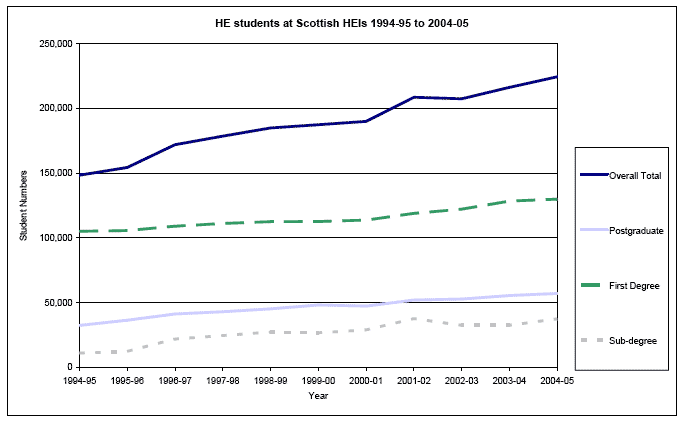
Source: Higher Education Statistics Agency ( HESA)
Publication
Students in Higher Education at Scottish Institutions: 2004-05 (Published 2006)
Higher Education Students at Further Education Colleges ( FECs)
Over the period 1994-95 to 2004-05 there has been a fall in the number of students undertaking HE level study in Scotland's FECs. Although the drop over this period is relatively modest at 5%, there has been a far greater fall in this number since the numbers peaked in 2000-01. Since this peak year (the period 2000-01 to 2004-05), HE students in FECs have fallen by 28% from 72,950 to 52,315.
Since 1994-95 there has been a 6% increase in the number of students undertaking full-time HE study in FECs. There are now 25,625 students of this type.
In contrast, there has been drop in the number of students studying part-time HE in FECs. There are now 26,690 HE students studying part-time, representing a decrease of 13% since 1994-95.
Since peaking in 2000-01, student numbers have fallen by 28%. Although full-time student numbers have increased since 1994-95, they have fallen by 18% since 2000-01. Part-time numbers have fallen by 36% over the same period.
The majority (98%) of HE students in Scotland's FECs are undertaking study at sub-degree level. This is consistent amongst both the full and part-time cohort.
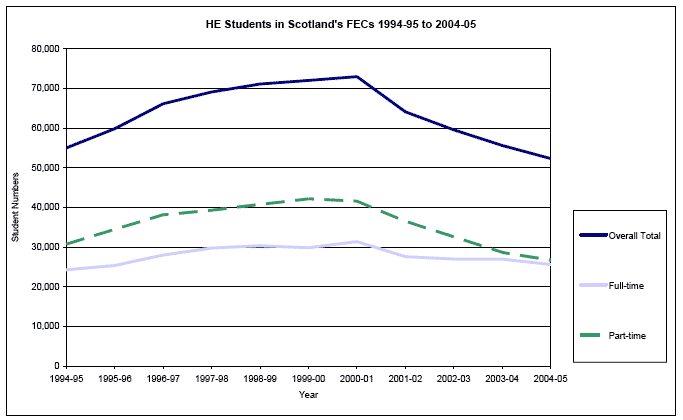
Source: Scottish Funding Council ( SFC)
Publication
Students in Higher Education at Scottish Institutions: 2004-05 (Published 2006)
Students in Higher Education
Higher Education Graduates from HEIs and FECs
Over the period 1996-97 to 2003-04, the number of HE graduates peaked in 1999-00 at 68,385. Since this peak, the number of graduates fell in both 2000-01 and 2001-02, before increasing again in 2002-03 and 2003-04.
The number of HE graduates in Scotland in 2003-04 was 65,720. This represented an increase of 3.2% on the 2002-03 figures.
The number of HE graduates from Higher Education Institutions has increased by 21.4% since 1996-97 to its current level of 45,565 graduates. In contrast, the number of HE graduates from Further Education Colleges has decreased by 11.2% since 1996-97 to its current level of 20,160 graduates.
The contribution of HE graduates from HEIs to the total number of HE graduates has increased from 62% in 1996-97 to 69% in 2003-04. There has been a corresponding drop in the contribution of HE graduates from FECs to the total from 38% to 31%.
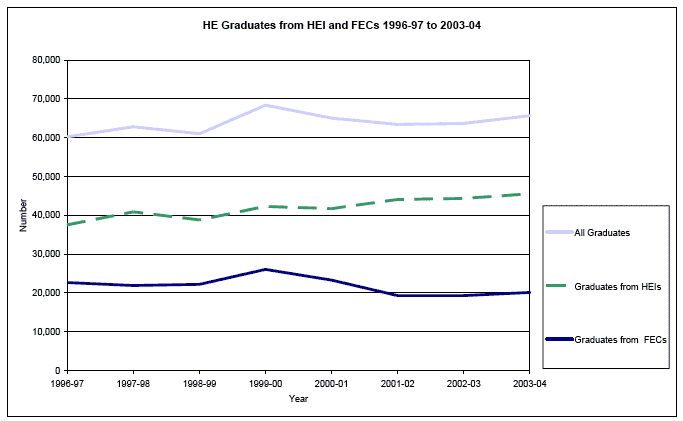
Source: Higher Education Statistics Agency ( HESA) and Scottish Funding Council ( SFC)
Publication
Higher Education Graduates And Graduate Destinations 2003-04 (Published 2005)
Age Participation Index ( API)
The Scottish Age Participation Index ( API) for a given year is defined as the number of young Scots aged under 21 who enter a full-time HE course for the first time in that year taken as a percentage of the population of 17 year olds at 31 December in the same year. In simple terms it is an estimate of the share of 17 year olds in the population who can be expected to enter HE for the first time before their 21 st birthday , if current trends continue.
In 2003-04, the Age Participation Index for Scotland was 48.9%. This was unchanged from 2002-03. The index has been just around the 50% mark for the past 7 years, reaching 51.5 between 2000 and 2002.
Over the same time period participation by women has been around 10 percentage points higher than by men; in 2003-04 the API for females was 54.2% while the figure for males was 43.8%.
Components of the index have been calculated by level of study and type of institution attended. Initial participation at degree level has risen by 1.8 percentage points since 1999-2000, standing at 29.7% in 2003-04. The sub-degree component of the API remained at the same level as the previous year, at 19.2%. This is a decline by 1.8 percentage points since 1999-2000.
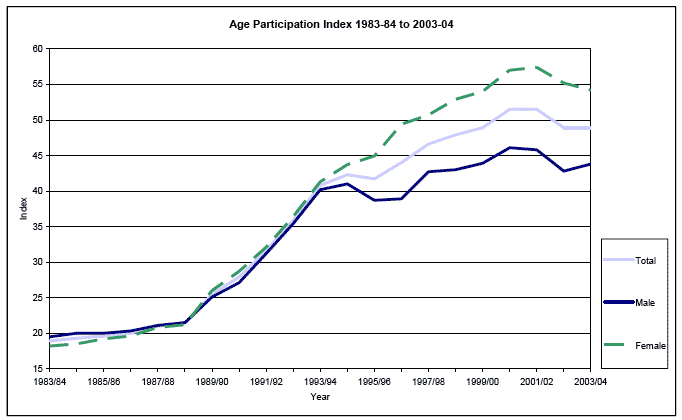
Source: Scottish Executive Lifelong Learning Statistics, Higher Education Statistics Agency ( HESA) and Scottish Funding Council ( SFC)
Publication
The Age Participation Index For Scotland 2003-04 (Published 2006)
Students in Further Education
FE Students at Scotland's Colleges ( FECs)
The number of further education enrolments at FE level in Scotland's colleges has increased dramatically since 1994-95. There are now 398,120 FE enrolments, an increase of 88% since 1994-95.
There has been a steady decline in FE enrolments since peaking in 2001-02. Enrolments have fallen from 450,790 in 2001-02 to their current level, which represents a decrease of 12% over this period.
The majority of enrolments at FE level are for vocational courses. In 2004-05 vocational enrolments accounted for 86% of the total. Vocational enrolments have increased by 82% since 1994-95, but have fallen by 12% since 2001-02.
Fourteen per cent of enrolments are at non-vocational level. Over the period 1994-95 to 2004-05, non-vocational enrolments increased by 128%. Non-vocational enrolments have fallen by 7% since 2001-02.
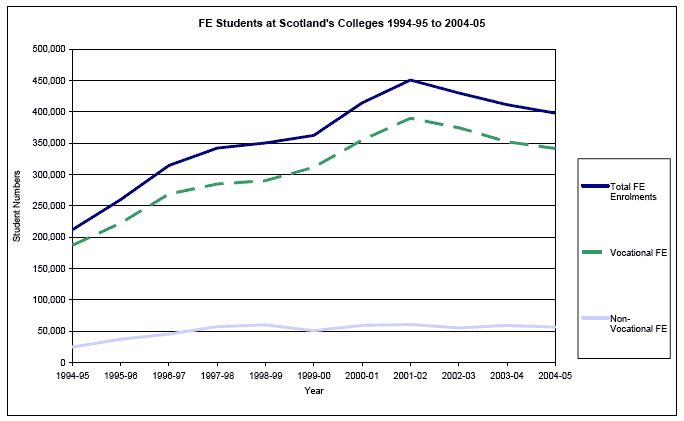
Source: Scottish Funding Council ( SFC)
Publication
Lifelong Learning Statistics 2005 (Published 2005)
Financial Support for Learners
HE student support
The Student Awards Agency for Scotland ( SAAS) support Scottish-domiciled higher education students studying at institutions in Scotland and elsewhere and EU-domiciled students studying in Scotland.
Over the period 1997-98 to 2004-05, the total number of HE students supported by SAAS has increased by 7% to 120,525.
Over the same time period the number of students receiving tuition fee support has remained fairly constant (although there was a dip in 1999-00 due to the abolition of tuition fee support in that year). In 2004-05 there were 109,955 students receiving tuition fee support, a decrease of 1% since 1997-98.
SAAS have calculated student loan entitlement since 1999-00 (prior to this students applied directly to their institution) and since this time there has been a marked rise in the number of students receiving loan support. 86,440 students received loan support in 2004-05, an increase of 70% since 1999-00.
The number of students receiving non-repayable financial awards since 1997-98 has fallen by 29% to 57,825. However, the number of young students, students with dependents and students with disabilities receiving award support has increased by over 255 in this period to 40,465 students.
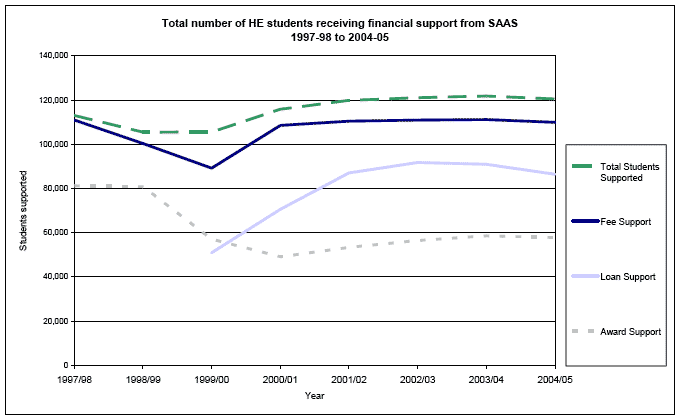
Source: Student Awards Agency for Scotland ( SAAS)
Publication
Student Awards In Scotland 2004-05 (Published 2005)
There is a problem
Thanks for your feedback